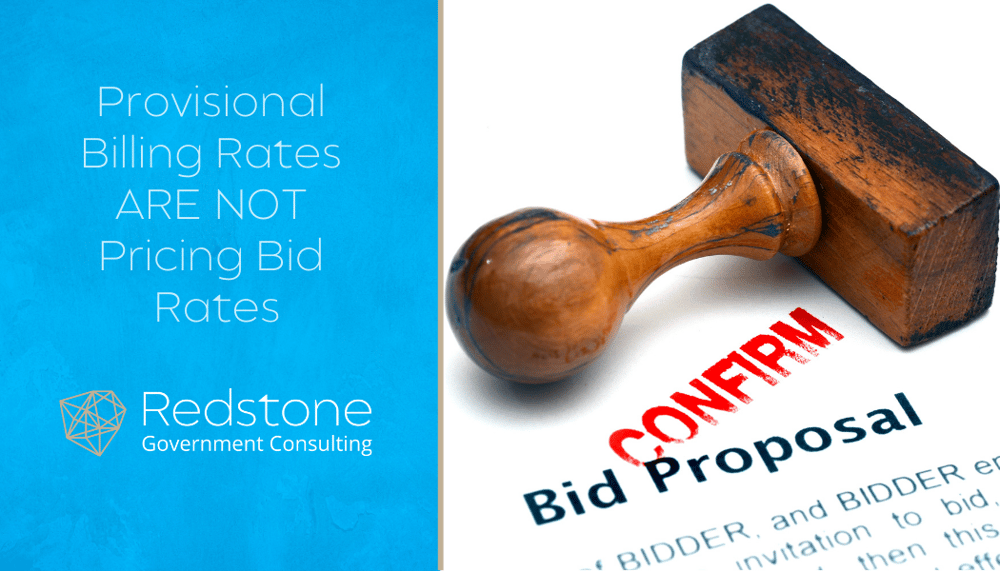
Provisional billing rates are established by either the ACO (Administrative Contracting Officer) or DCAA (Defense Contract Audit Agency). As described in a 2014 DCAA Audit Policy (MRD 14-PPS-012, dated July 22, 2014), per FAR 42.704, provisional billing rates should be established early within a contractor fiscal year for purposes of invoicing indirect costs (on cost-type contracts or any contract which ultimately requires final indirect cost rates per FAR 42.705). For anyone familiar with FAR, it is self-evident that provisional billing rates are based upon FAR Part 42, which details contract administration versus proposal contract pricing, (typically FAR Part 15, if cost or pricing data is required). Although there may be similarities, the proposal process involves solicitation clauses, whereas a contract award contains contractual clauses.
Why mention FAR Part 15 juxtaposed with FAR Part 42? To highlight the fact that bid rates (forward pricing rates) are intertwined with FAR Part 15, numerically and chronologically preceding provisional billing rates linked to FAR Part 42. Of utmost importance, to emphasize that simplistically using provisional billing rates as forward pricing bid rates is becoming a recipe for disaster (under the informal laws of unintended consequences). Recent (client) experience, proposing provisional billing rates, and specifically describing them as such, resulted in bid losses because the source selection official could not determine a probable cost for the contractor. By definition, provisional billing rates apply to a current fiscal year with no assumption that these current year rates are a reasonable projection of indirect rates for subsequent years. Unless a solicitation and its contemplated period of performance is extremely narrow (within a current fiscal year), the provisional billing rates simply do not address rates for subsequent years. From the perspective of the government source selection official or his/her team, the government is theoretically left without any contractor (bidder) support for out-year indirect costs. The government cannot assume that the bidder’s current fiscal year provisional billing rates are a reasonable projection of that bidders’ forecasts, budgets, and forward pricing rates.
In addition, the use of provisional billing rates leaves unanswered the question of bid rates based upon an assumption that the bidder will be awarded the contract. In some cases, solicitations expressly state that requirement, i.e. the bidder must be able to demonstrate that its bid rates include an assumed win (for example, that the indirect allocation bases factor in the base generated by the contract). Although the government has the option to adjust a bidder’s cost estimate, the government is not required to correct a bid by supplying forward pricing bid rates in place of provisional billing rates. Not that it changes the requirement for potential contractors (bidders), but government price or cost analysts have also fallen into the trap of using provisional billing rates as the sole basis for a cost realism analysis. In one recent case, the government cost analyst used 2013 provisional billing rates, (the only “government approved” rates he/she had, and significantly increased the bidder’s cost estimate. The bidder was then considered outside the cost competitive range; however, the bidder successfully protested and the evaluation/source selection was re-opened.
Provisional billing rates “might” be reasonable for forward pricing, but a responsive bidder must consider the future, not only the past and present. Hence, some contractors attempt to develop a forecast that is presented as “projected rates” and absolutely not described as provisional billing rates. If there is one specific point of reference, it is the DCAA provisional rate letter establishing provisional billing rates. This letter includes the following restriction:
“The established rate shall not be used for any other purpose than for provisional billing rates (e.g. forward pricing or final indirect cost rates”.
Although DCAA cannot dictate contractor forward pricing rates that “might be” essentially the same as the DCAA established provisional billing rates, the DCAA restriction is all-too often accepted at face value by a source selection official in evaluating a contractor proposal. Thus, if I simply use them, and even worse, represent them as DCAA approved rates, I am ignoring the DCAA restriction.
Unlike provisional billing rates (FAR 42.704), contractor forward pricing rates are embedded within the FAR 15.408, Table I5-2, II C. Indirect Costs:
“Indicate how you have computed and applied your indirect costs, including cost breakdowns. Show trends and budgetary data to provide a basis for evaluating the reasonableness of proposed rates (emphasis added).”
In the case of contractors with a high volume of pricing, FAR 15.407-3 Forward Pricing Rate Agreements (FPRA) may apply, implicating a detailed Forward Pricing Rate Proposal (FPRP) and possibly a FPRA. In any case to support a bid, the potential contractor should categorize its rates as Forward Pricing Rates (FPR). Historical rates and/or provisional billing rates may then be included to support the reasonableness of the FPRs. Never simply propose provisional billing rates to support a cost estimate.
Preparing Forward Pricing Rates may seem as daunting as attempting to predict the future; however, it is about maintaining structural comparability to historical rates, yet considering the future and developing and documenting assumptions about the future.


 Mike Steen is a Emeritus Advisor with Redstone Government Consulting, Inc. and a specialist in complex compliance issues to include major contractor cost accounting & business system regulations, financial compliance, resolution of DCAA audit issues, Cost Accounting Standards application, litigation support, and claims preparation. Prior to joining Redstone Government Consulting, Mike served in a number of capacities with DCAA for over thirty years, and upon his retirement, he was one of the top seven senior executives with DCAA. Mike Served as a Regional Director for two DCAA regions, and during that time was responsible for audits of approximately $25B and 800 employees. In October 2001, he was selected for the Senior Executive Service and in 2006 he received the Presidential Rank Award. During Mike’s tenure with DCAA, he was involved in conducting or managing a variety of compliance audits, to include cost proposals, billing systems, Cost Accounting Standards, claims, defective pricing, and then-evolving programs such as restructuring, financial capability and agreed-upon procedures. He directly supported the government litigation team on significant contract disputes and has prepared and presented various lectures and seminars to DCAA staff and business community leaders. Since joining Redstone Government Consulting in June 2007, Mike has developed and presented training and seminars on Government Contracts Compliance to NCMA, Federal Publications Seminars and various clients. Mike also is a prolific contributor of written articles to government contracting publications, as well as to our own Government Insights Newsletter. Mike also serves as the director of our training service offerings, with responsibilities for preparing and developing course content as well as instructing our seminars to clients and general audiences throughout the U.S. Mike also serves as a faculty instructor for the Federal Publications Seminars organization. Education Mike has a BS Degree in Business Administration from Wichita State University. He is also a graduate of the DCAA Director’s Fellowship Program in Management, and has a Masters Degree in Administration from Central Michigan University. Mr. Steen also completed a number of OPM’s management and executive development courses.
Mike Steen is a Emeritus Advisor with Redstone Government Consulting, Inc. and a specialist in complex compliance issues to include major contractor cost accounting & business system regulations, financial compliance, resolution of DCAA audit issues, Cost Accounting Standards application, litigation support, and claims preparation. Prior to joining Redstone Government Consulting, Mike served in a number of capacities with DCAA for over thirty years, and upon his retirement, he was one of the top seven senior executives with DCAA. Mike Served as a Regional Director for two DCAA regions, and during that time was responsible for audits of approximately $25B and 800 employees. In October 2001, he was selected for the Senior Executive Service and in 2006 he received the Presidential Rank Award. During Mike’s tenure with DCAA, he was involved in conducting or managing a variety of compliance audits, to include cost proposals, billing systems, Cost Accounting Standards, claims, defective pricing, and then-evolving programs such as restructuring, financial capability and agreed-upon procedures. He directly supported the government litigation team on significant contract disputes and has prepared and presented various lectures and seminars to DCAA staff and business community leaders. Since joining Redstone Government Consulting in June 2007, Mike has developed and presented training and seminars on Government Contracts Compliance to NCMA, Federal Publications Seminars and various clients. Mike also is a prolific contributor of written articles to government contracting publications, as well as to our own Government Insights Newsletter. Mike also serves as the director of our training service offerings, with responsibilities for preparing and developing course content as well as instructing our seminars to clients and general audiences throughout the U.S. Mike also serves as a faculty instructor for the Federal Publications Seminars organization. Education Mike has a BS Degree in Business Administration from Wichita State University. He is also a graduate of the DCAA Director’s Fellowship Program in Management, and has a Masters Degree in Administration from Central Michigan University. Mr. Steen also completed a number of OPM’s management and executive development courses.